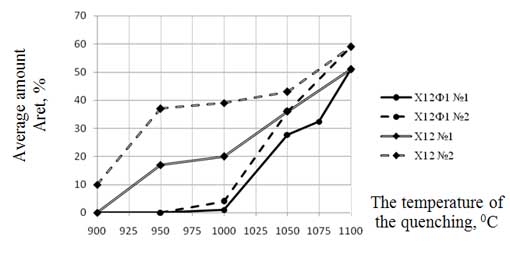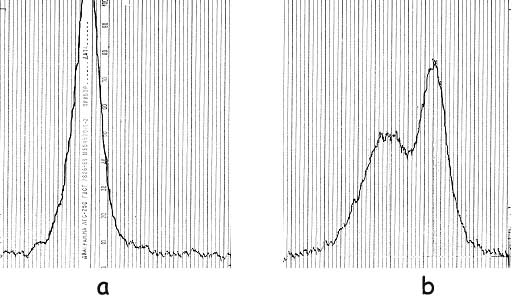



Faculty:
Department:
Speciality:
Scientific adviser:
Theme of master's work:
Physical-and-metallurgycal
Physical material Sience
Applied material science
professor Vladimir Pashinsky
About Influence of the Temperature of Kh12-type Steels Quenching on Correlation of the Hardness and Amount of the Retained Austenite
ABSTRACT:
The hardness of Kh12-type steels correlates with amount of a retained austenite not always, especially, if there are many retained austenite in the steel or if it`s metastable. For checking of this statement the speciments from Kh12 and Kh12F1 steels with a different chemical compound have been quenched from different temperatures (900-1100°С). Then hardness has been measured on the speciments (table 1).
Table 1 – Hardness after the quenching, HRC
| Mark of steel | The temperature of the quenching, °С | ||||
| 900 | 950 | 1000 | 1050 | 1100 | |
| Kh12 №1 | 58±2 | 64±1 | 63±1 | 60±1 | 63±1 |
| Kh12 №2 | 60±1 | 64±2 | 64±1 | 64±0,5 | 62±2 |
| Kh12F1 №1 | 58±2 | 61±1,5 | 59±1 | 58±1,5 | 62±1 |
| Kh12F1 №2 | 58±1 | 62±2 | 62±2 | 61±2 | 61±0,5 |
From the received results we can see that the peak of hardness after the quenching from 950°С is: 64 HRC – for Kh12, 61 and 61 HRC – for Kh12F1 №1 and Kh12F1 №2 accordingly. However, there is abnormal high hardness after the quenching from temperatures 1050-1100°С.
Kh12-type steels concern to a carbidic class, that’s why influence of temperatures of the quenching on a condition of carbides in the structure has been studied. There are primary and secondary carbides in the structure. The sizes of carbides and their maintenance in structure have been calculated by means of the program ImageTool. Carbides have the greatest size into the steel Kh12 №1, the least – into the steel Kh12F1 №2. The sizes of change with rise of temperature of the quenching. Primary carbides practically don`t change the sizes and the form, and secondary carbides have been gradually dissolved.
The maintenance of carbides in structure decreases with rising the quenching temperature. It is possible to explain with their dissolution. The greatest amount of the carbides is into the speciments from Kh12F1 steels after the quenching from 900°С – 15 %, this number is decreasing to 10% during increasing the temperature. The quantity of carbides in structure initially different into Kh12 №1 and №2 steels – 15 % and 12 % accordingly, but this number is equal 10 % for both marks after the quenching. There was much more secondary carbides into Kh12 №1 steel, than into Kh12 №2 steel in the beginning, but they were dissolved. Only primary carbides remained.
Both types of carbides are visible very well in figure 1,а: primary (eutectic) carbides look like the extended plates, secondary are close under the form to the spherical. Structures of the Kh12 steel after quenching from 950°С and 1000°С are shown in figure 1,c and 1,d. This steels has fine grain (figure 1,b).

a – Kh12 №2 after the guenching from 950°С;
b – Kh12F1 №1 after the guenching from 1000°С;
c – Kh12 №1 after the guenching from 950°С;
d – Kh12 №1 after the guenching from 1000°С;
Figure 1 – Steel microstructure, х400
The method the X-rays analysis had been revealed amount of a retained austenite into the steels (table 2).
Table 2 – Amount of a retained austenite into the steels after the quenching
| Mark of steel | The temperature of the quenching, °С | Аret on the microsection, % | Аret, maximum, % | Аret, average, % |
| Kh12 №1 | 1100 | 22 | 58 | 51 |
| 1050 | - | 36 | 36 | |
| 1000 | 2 | 26 | 20 | |
| 950 | - | 17 | 17 | |
| 900 | - | - | - | |
| Kh12 №2 | 1100 | - | 60 | 59 |
| 1050 | - | 49 | 43 | |
| 1000 | 22 | 44 | 39 | |
| 950 | 17 | 40 | 37 | |
| 900 | - | 10 | 10 | |
| Kh12F1 №1 | 1100 | 19 | 43 | 43 |
| 1050 | - | 16 | 16 | |
| 1000 | - | 1 | 1 | |
| Kh12F1 №2 | 1100 | - | 59 | 59 |
| 1050 | - | 36 | 36 | |
| 1000 | 3 | 4 | 4 |
The amount of the retained austenite sharply increases with increasing the temperature of the quenching, for example, for Kh12 №1 steel practically from zero after quenching from 900°С to 58 % after quenching from 1100°С. The amount of the retained austenite is about 60 % into the steels which was quenched from high temperature, but that fact is contradicts high hardness. It can be explained by transformation the austenite into the strain-induced martensite under the influence of the indentor during the hardness measurement. The changing of amount of the retained austenite into the steels after quenching depending on quenching temperature is resulted in figure 2.

Figure 2 - The changing of amount of a retained austenite into the steels after quenching depending on quenching temperature
One interesting singularity has been revealed during the X-ray analysis: the austenite lines have low intensity from a microsection site and very high from the other sides of the same specimen. This singularity is traced absolutely on all speciments after all temperatures of quenching and is shown in figure 3.

Figure 3 - The roentgenogram of Kh12F1 №2 steel quenched from 1100°С:
a - from the microsection
b - from the other side
The influence of the quenching temperature on correlation of the hardness and amount of the retained austenite of Kh12-type steels is studying in this work. The results of preliminary experiments give the chance to speak about that:
- On the speciments after quenching from high temperatures was fixed abnormal high hardness which does not correlating to amount of a retained austenite;
- Relative intensity of the diffraction lines of the austenite which has been removed from the microsections, much more low, than from the other sides of the speciment in all cases.
The literature list:
- Гольдштейн М.И, Грачев С.В., Векслер Ю.Г. Специальные стали – М.: «Металлург», 1985 – С. 409;
- Инструментальные стали. Справочник/ Л.А. Позняк, С.И. Тишаев и др. – М.: Металлургия, 1977. – С. 167;
- Позняк Л.А. Штамповые стали – М.: Металлургия, 1980 – С. 244;
- Ланская К.А., Матросов Ю.И., Куликова Л.В., Горчакова Э.Н., Корешкова А.М. Пути повышения свойств теплоустойчивых сталей при рабочих температурах до 650°С//Сталь – 1982, №4. – С.79-82;
- Геллер Ю.А. Инструментальные стали – М.: Металлургия, 1983 – С. 528;
- Тюрин Н.Ф. Разработка и исследование теплостойких низковольфрамовых штамповых сталей//Автореферат диссертации на соискание научной степени кандидата технических наук – Донецк: ДонНТУ, 1981. – С.19;
- Сулейманов Н.М., Гусейнов Р.К., Сулейманова С.Н. Влияние способа закалки на структуру стали Х12М//Металловедение и термическая обработка – 1999, №12. – С. 12-15;
- Сулейманов Н.М., Айвазов Б.Ю., Сулейманова С.Н. Двухступенчатая закалка стали Х12М//Металловедение и термическая обработка – 1999, №11. – С. 18-20;
- Шнейдерман А.Ш. О распределении остаточного аустенита в закаленных инструментальных сталях// Металловедение и термическая обработка – 1993, №5.– С. 24-25.
- Шнейдерман А.Ш. О структуре стали Х12МФ после вакуумной закалки//Металловедение и термическая обработка – 1993, №2. – С.9-12.
DonNTU > Master's portal > Library | Links

